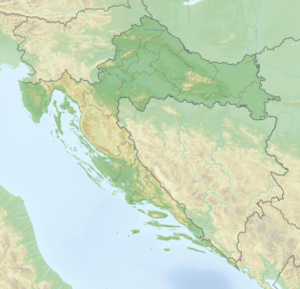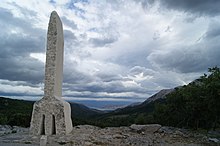Krk
| Krk | ||
|---|---|---|
| Satellite image of Krk | ||
| Waters | Adriatic Sea , Kvarner | |
| Geographical location | 45 ° 5 ' N , 14 ° 36' E | |
|
|
||
| surface | 405.78 km² | |
| Highest elevation |
Obzova 568 m |
|
| Residents | 17,860 (2001) 44 inhabitants / km² |
|
| main place | Krk (city) | |
| Detailed map of the island | ||
Krk [ kr̩k ] ( Latin Curicta , Italian Veglia , Dalmatian Vikla , German obsolete Vegl ) is a Croatian island in the Adriatic Sea and, according to recent measurements, with 405.78 km² together with the island of Cres, which is exactly the same size, the largest island in the Adriatic. It is located in the Kvarner Bay southeast of Rijeka . The Krk Bridge has connected Krk to the mainland since 1980. Around 17,800 people live on the island. The administrative center of the island is the city of Krk .
geography
Krk has the most populated places of all Croatian islands, namely 68. The island is traditionally divided into the seven municipalities Baška (German Weschke , Italian Besca ) with 1752 inhabitants, Dobrinj ( Dobrauen , Dobrigno ): 2108 inhabitants, Malinska-Dubašnica ( Durischal , Malinsca ): 3394, Omišalj ( Moschau , Castelmuschio ): 3098, Punat ( Sankt Maria , Ponte ): 2028, city of Krk , 6494 and Vrbnik ( Vörbnick , Verbenico ): 1245 inhabitants in 2011.
There are two lakes on Krk (Jezero and Ponikve), several small rivers including Vela Rika , Dobrinjski Potok and Vretenica, and several caves. The Biserujka Cave in the Dobrinj Municipality is open to tourists. It is 13 meters underground and the temperature in the cave is just under 15 degrees.
Flora and fauna
There are around 1300 different plant species on the island, including characteristic tree species such as hard oak and downy oak as well as European hop beech and oriental hornbeam .
More than 220 bird species have been identified so far. The island serves as a resting place for numerous Central and Northern European birds as they pass through. Some species even winter on the island. Griffon vultures nest on the south-eastern cliff , which is why the coastal strip there between Glavina and Mala Luka was declared an ornithological reserve with a width of 1 km as early as 1969 .
The number of occurring on the island mammal species, however, is relatively low, and most of them were from people introduced . It happens that brown bears from the mainland swim to the island via the Velebit Channel in order to open up new territory .
A single author was able to register a total of 852 determinable butterfly species between 1984 and the end of 1988 .
Including the controversial findings of Bruno and Sochurek, Krk has the richest herpetofauna of all Mediterranean islands with 32 species, just ahead of Cres with 30 and Sicily with 27 species . The ruin lizard , which can be found almost everywhere, is particularly characteristic ; it probably only immigrated from Italy a few thousand years ago and has largely displaced the long-established Adriatic wall lizard . Among the twelve species of snake on the island, the European horned snake is the only venomous snake , but the Balkan angry snake , the yellow-green angry snake and the Aesculapian snake are far more common .
history
The first known settlers were the Japods , who belonged to the Illyrian tribal group . The current name of the island comes from this period, the roots of which lie in the Illyrian name Kurik . Ancient writers called the island Kyriktike, Kurikta, Kurikon, K (u) R (y) K (ta), or Kuryeta, the Romans called it Insula aurea 'golden island' because of its natural wealth , the city of Krk proudly called itself Splendidissima civitas Curictarum 'Most radiant city in Krker' . During the Roman Civil War , the island's bay was the scene of a naval battle between the troops of Caesar and Pompey .
In the vicinity of Njivice there are still ruins of the Roman settlement Fulfinium .
The Japods were later ousted by the Liburnians , who were excellent shipbuilders and sailors and used this skill for their own purposes. They established good relationships throughout the Mediterranean, with contacts with Greek traders. The Liburnians use the favorable location of the city and the island for themselves, as the Amber Road from the Baltic States to the Mediterranean ran through this area. The Greek trade routes from the Black Sea towards the northern Adriatic could also be controlled very well from here. At that time, the city of Krk had not yet developed into the center of the island.
Since then, over the centuries, the island has been predominantly occupied by various occupying powers , namely the Romans, Venetians , Hungarians , Austrians , French and Italians . Since the 12th century, the island has been under the Frankopan noble family .
In 1919 Krk came together with the rest of Croatia to the Kingdom of Serbs, Croats and Slovenes , which in 1929 became part of the Kingdom of Yugoslavia .
From September 1943 to May 1945 the island together with the town of Sušak formed the "Commissariat Suschak-Krk" (Italian "Commissariato straordinario per i territori di Sušak-Krk"), a kind of buffer zone between RSI / OZAK and NDH .
Krk has been one of the centers of Croatian culture throughout its history . One of the most important written testimonies of the Croatian language is the Baška tablet from 1100. This inscribed stone slab, discovered in the Romanesque St. Lucija chapel near the village of Baška , bears an inscription in Glagolitic script . It describes the sovereignty of the Croatian King Zvonimir I as the founder of the chapel. The noble family of Frankopans, which was very important in the history of Croatia , was originally elevated to the rank of prince on the island of Krk.
Because the island belonged to the Republic of Venice for centuries, Vegliotic was spoken in parts of the island until the 19th century , an independent idiom that represented a variety of the Dalmatian language .
population
The population development since modern times shows that the number of inhabitants reached its peak towards the end of the 19th century. The basis for this was above all the then prospering viticulture, which, however , experienced a sudden recession due to massive damage from phylloxera and increased competition between Italian wines in the transition to the 20th century .
| year | 1525 | 1527 | 1539 | 1603 | 1636 | 1727 | 1770 | 1853 | 1880 |
|---|---|---|---|---|---|---|---|---|---|
| Residents | 10,000 | 10,461 | 8,000 | 6,637 | 5,000 | 8,000 | 9,571 | 15,570 | 18,089 |
| year | 1890 | 1921 | 1931 | 1948 | 1953 | 1961 | 1971 | 2001 | 2011 |
| Residents | 22,230 | 20,842 | 20,043 | 17,689 | 16,820 | 14,548 | 13.110 | 17,860 | 20,165 |
Culture and religion
On the island of Krk, which has been the seat of a bishopric since the Middle Ages , the Roman-Slavic liturgy has been practiced for about a thousand years . The mass has always been celebrated according to the Roman rite , but in Church Slavonic . After the introduction of the mother tongue (here Croatian ) in Catholic worship by the Second Vatican Council , this tradition lost its importance. The island was also a center of Glagolitic literature , as evidenced by the Baška Tablet and the Glagolitic Path in the Baška Općina . Under Bishop Antun Mahnić (1896–1920), the Old Slavic Academy was established in 1902 with its seat on Krk; this ecclesiastical institute existed until 1927.
Economy and Infrastructure
The Krk wine region ( Croat . Krčko vinogorje ) is known for the Žlahtina white wine cultivated in the municipality of Vrbnik , and olive trees are also cultivated in many parts of the island. Apart from that, it offers relatively few opportunities for agriculture, so that the inhabitants have been using the Karstland for centuries to raise sheep (and, more rarely, cattle ) to produce wool , meat and cheese .
Krk is fully developed for tourism and is a popular holiday destination due to its location and proximity to southern Germany , Austria and northern Italy . After the collapse of the Eastern Bloc , many vacationers from Hungary , the Czech Republic , Romania and other former Eastern Bloc countries came to Krk. Rijeka-Riviera Kvarner Airport (RJK) is located in the northeast of the island .
Baška tablet (around 1100)
Others
- Schobert and Black mentioned the island in one of their limericks .
- Hans Lang and Erich Meder wrote the hit song Once I was on the island of Krk , sung by Franz Schier in 1939.
- The island served as a template for the Everon model island world for the computer game Operation Flashpoint
literature


- Anton Bozanić; Petar Strčić: Mahnić i njegova Staroslavenska akademija . Krk / Rijeka 2002. ISBN 953-7030-01-6 .
Individual evidence
- ↑ Croatian Statistical Office, 2009 (PDF file; 415 kB)
- ↑ Vrbnik on the island of Krk: Info 2020, photos & travel guide with video. In: Baska-Krk.de. May 14, 2019, accessed on March 29, 2020 (German).
- ↑ a b Denis Lešić: The island of Krk: a travel guide in words and pictures . Aquanet, Krk 2003, ISBN 953-7122-01-8 .
- ↑ Heinz Habeler : Lepidopterologische Nachrichten aus der Steiermark, With find data from the northern Adriatic region (PDF file; 1.5 MB). April 20, 1989, Landesmuseum Joanneum Graz, Austria.
- ↑ a b Tamás Tóth, Heinz Grillitsch, Balázs Farkas, János Gál, Goran Sušić: Herpetofaunal data from Cres Island, Croatia (PDF file; 4.7 MB). Herpetozoa 19 (1/2): 27-58, 2006
- ↑ Strabon's description of the earth. First part, seventh book, fifth section, § 5
- ↑ Matthias Gelzer : Pompeius: Life picture of a Roman . Franz Steiner Verlag , ISBN 3-515-08474-6
- ↑ Ancient city and early Christian complex in the Sepen Bay near Omišalj ( Memento from August 26, 2002 in the Internet Archive )
- ↑ a b Mihovil Bolonić, Ivan Žic Rokov: Otok Krk kroz vijekove. Kršćanska Sadašnjost, Zagreb 1977.










